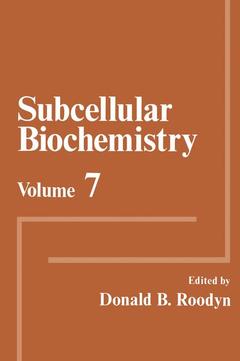1 Biogenesis of Ribosomes in Eukaryotes.- 1. Introduction.- 2. Ribosomal Genes.- 2.1. Ribosomal RNA Genes.- 2.2. 5 S rRNA Genes.- 2.3. General Features.- 3. Transcription of Ribosomal RNA Genes.- 3.1. Components of the Transcription Complex.- 3.2. The Transcription Process.- 3.3. Transcription in Vitro.- 4. Processing of Primary Pre-rRNA and Preribosomes.- 4.1. Structure of Primary Pre-rRNA.- 4.2. Pre-rRNA Maturation Pathways.- 4.3. Preribosomes: Structure and Processing.- 5. Regulation.- 5.1. General Considerations.- 5.2. Transcriptional Control.- 5.3. Posttranscriptional Control.- 6. Concluding Remarks.- 7. References.- 2 The Role of Ribonucleic Acids in the Organization and Functioning of Ribosomes of E. coli.- 1. Introduction.- 2. The Secondary Structures of Ribosomal RNA in Ribosomes.- 3. Compact Folding of RNA in Ribosomal Subunits.- 4. Domain Organization of Ribosomal Subunits.- 5. Role of Ribosomal Proteins in the Organization of RNA Tertiary Structure within Ribosomal Subunits.- 6. Direct Participation of Ribosomal RNA in Ribosome Functioning.- 7. Topography of rRNA in Ribosomes.- 8. Addendum: A Preliminary Model for the Secondary Structure of 16 S Ribosomal RNA.- 9. References.- 3 Aspects of the Role of the Endoplasmic Reticulum in Protein Synthesis.- 1. Introduction.- 2. Membranes of the Endoplasmic Reticulum.- 2.1. The Composition and Structure of the Endoplasmic Reticulum Membranes.- 2.2. Functional Aspects of the Endoplasmic Reticulum.- 3. Protein Synthesis.- 3.1. Protein Synthesis by Free and Membrane-Bound Polysomes.- 3.2. Secreted Proteins May Be Synthesized Solely on Membrane-Bound Polyribosomes.- 3.3. Proteins Synthesized on Membrane-Bound and/or Free Polysomes.- 3.4. Summary.- 4. Polyribosome-Membrane Interactions.- 4.1. The Physical Nature of Binding between 60 S Subunits and Membrane.- 4.2. Interaction between Nascent Polypeptides and Membranes.- 4.3. Direct Interaction between Messenger RNA and Membranes.- 5. Heterogeneity in the Function of Rough Endoplasmic Reticulum with Respect to Protein Synthesis.- 5.1. Compartmentalization of the Synthesis of Proteins Destined for Discharge to the Extracellular Environment.- 5.2. Compartmentalization of Protein Synthesis in the Endoplasmic Reticulum and Specific Posttranslational Modifications.- 5.3. Compartmentalization of the Synthesis of Specific Proteins at Discrete Sites within the Rough Endoplasmic Reticulum.- 6. Conclusions.- 7. References.- 4 Biogenesis of Peroxisomes and Glyoxysomes.- 1. Introduction.- 2. Morphology and Topographical Relationship to Other Cellular Organdies.- 3. Biochemical Properties and Metabolic Roles.- 3.1. Liver Peroxisomes.- 3.2. Leaf Peroxisomes.- 3.3. Fatty Seed Glyoxysomes.- 4. Microbody Proliferation.- 4.1. Liver Peroxisomes.- 4.2. Leaf Peroxisomes.- 4.3. Fatty Seed Glyoxysomes.- 5. Models for the Synthesis of Microbody Components and Their Transfer to the Organelles.- 5.1. Membrane Lipids.- 5.2. Membrane Proteins.- 5.3. Implications for Microbody-Membrane Biogenesis.- 5.4. Microbody Matrix Proteins.- 5.5. Implications for Microbody Matrix Protein Segregation.- 6. The Synthesis of Microbody Components.- 6.1. Membrane Lipids.- 6.2. Membrane Proteins.- 6.3. Matrix Proteins.- 7. References.- 5 The Subcellular Biochemistry of Thyroid.- 1. Introduction.- 2. Cell Fractionation.- 2.1. Disruption and Homogenization of Thyroid Tissue.- 2.2. Localization of Marker Enzymes in Thyroid (Preliminary Studies).- 2.3. Differential Pelleting.- 2.4. Gradient Centrifugation Studies.- 2.5. Localization of Biochemical Markers (Supplementary Studies).- 3. Localization of Enzymes and Constituents in Bovine Thyroid Tissue.- 3.1. Subcellular Localization of Lipolytic Enzymes.- 3.2. Subcellular Localization of Peroxidase Activities.- 3.3. Subcellular Localization of RNA-Polymerase Activity.- 4. Isolation and Characterization of Thyroid Organelles, Subcellular Components, and Membranes.- 4.1. Nuclei.- 4.2. Mitochondria and Lysosomes.- 4.3. Golgi-Rich Fractions.- 4.4. Protein-Synthesizing Polyribosomes.- 4.5. Plasma Membranes.- 5. Summary.- 6. References.- 6 The Molecular Organization of NADH Dehydrogenase.- 1. Introduction.- 1.1. The Purpose of This Chapter.- 1.2. Definitions and Terminology.- 1.3. The Functional Unit.- 2. The Protein Components of NADH Dehydrogenase.- 2.1. Fragmentation of the Enzyme.- 2.2. Fragmentation by Treatment with Chaotropic Agents.- 2.3. Polypeptide Composition of NADH Dehydrogenase and Its Subfragments.- 3. The Protein Structure of NADH Dehydrogenase.- 3.1. General Properties of Multisubunit Enzymes.- 3.2. The Nature of Chaotropic Resolution.- 3.3. Isoelectric Points of the Constituent Polypeptides.- 3.4. Labeling with Hydrophilic Probes.- 3.5. Labeling with a Hydrophobic Probe.- 3.6. Proteolytic Digestion.- 3.7. Specific Structure/Function Relationships.- 4. The Phospholipid Components of NADH Dehydrogenase.- 4.1. Are Phospholipids Essential?.- 4.2. Phospholipid Composition of NADH Dehydrogenase.- 4.3. Phospholipid Function.- 4.4. Specific Lipid-Protein Interactions.- 5. Organization of NADH Dehydrogenase in the Membrane.- 5.1. Transmembranous Organization.- 5.2. Lateral Organization.- 6. Conclusion.- 6.1. A Model of NADH Dehydrogenase Structure.- 6.2. Prospects.- 7. References.- 7 Structure-Function Relationships of Micrococcus lysodeikticus Membranes: A Bacterial Membrane Model System.- 1. Introduction.- 2. Ultrastructure of Bacterial Membranes.- 3. Biochemical Characterization of Micrococcus lysodeikticus Membranes.- 3.1. Enzyme Distribution.- 3.2. Enzymes Involved in Wall-Polymer Biosynthesis and Peptidoglycan Metabolism.- 3.3. Lipomannan Biosynthesis.- 3.4. Enzymes Involved in Lipid Biosynthesis.- 3.5. Electron-Transport Chain Components.- 3.6. Membrane Adenosine Triphosphatase (F1-ATPase).- 4. Antigenic Architecture of the Membrane of M. Lysodeikticus.- 5. Summary and Conclusions.- 6. References.- Some Recent Books in Cell Biochemistry and Biology.- 1. Cell and Membrane Biology.- 2. Genetics and Viruses.- 4. General Biochemistry.




